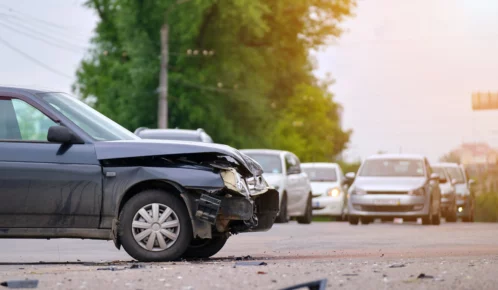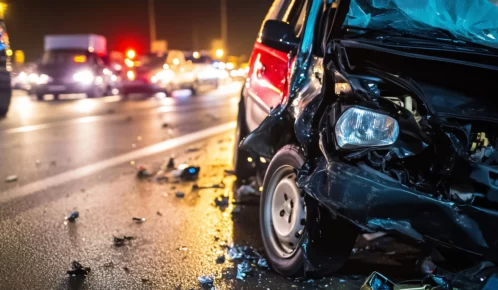Hit-and-run accidents occur when a driver of one motor vehicle is involved in a collision with another vehicle, pedestrian, cyclist, or object and leaves the scene without providing contact information, offering aid, or notifying authorities. Understanding more about what is considered a hit-and-run accident in Illinois can help you make informed decisions about how to proceed with your personal injury case.
Table of Contents

If you suffered injuries in a hit-and-run accident, your personal injury claim may be a bit more complicated, but you can still recover damages.
Our car accident lawyers at Ankin Law have over 100 years of combined experience handling cases where drivers have left the scene. We can help you recover compensation for your medical bills, lost wages, and pain and suffering. Call us at 312-600-0000. Consults are free.
What Is a Hit-and-Run in Illinois?
The simple definition of a hit-and-run accident is any incident where a driver causes a crash resulting in injuries or property damage and fails to remain at the scene. Illinois law requires drivers to stop after motor vehicle accidents, exchange information, and help any injured parties. Similar laws exist in all 50 states.
Unfortunately, many drivers in the U.S. don’t obey this law. In fact, there were over 850,000 hit-and-run accidents across the nation in 2022. More than 2,800 of those crashes were fatal, and over 189,000 caused serious injuries. Approximately 37,000 hit-and-run accidents happened in Chicago in 2021 alone, killing 36 people and injuring over 4,800.
Common Reasons People Leave the Scene in Hit-and-Run Car Accidents
People flee in hit-and-run accidents for many reasons. Most of these incidents involve an at-fault driver who was doing something illegal or who was afraid of the consequences of causing a crash.
Some common reasons people leave the scene in hit-and-run accidents include:
- Impaired Driving — Often, drivers flee the scene after causing an accident while drunk or otherwise impaired. They typically flee the scene to avoid the consequences of driving while impaired, such as driving under the influence (DUI) charges.
- Panicking — Some drivers may leave the scene of an accident out of panic. Even if they have a clean criminal record, they may flee out of fear of legal repercussions for causing injuries or property damage.
- Lack of Insurance — Drivers could leave the scene of an accident they cause because they’re uninsured or underinsured and don’t want to face potential legal charges for failing to carry sufficient insurance.
- No Driver’s License — Sometimes drivers flee after a car accident because they are not legally supposed to be driving. They might have an expired license, no license at all, or their driving privileges may have been suspended or revoked.
- Outstanding Warrants — Some cases may involve drivers who know they have outstanding warrants for previous offenses and want to avoid arrest.
How Are Hit-and-Run Drivers Identified?
Hit-and-run drivers can be identified using various methods, including:
Evidence Collected From the Scene
It’s possible to identify hit-and-run drivers using evidence left at the accident scene. This evidence may include everything from skid marks and paint remnants to debris, such as vehicle components resulting from vehicle damage. Footage from dash cams and nearby traffic or security cameras can also help identify a hit-and-run driver.
Eye Witness Testimony
Any witnesses present at the scene of the accident may also be able to help identify a hit-and-run driver. They may remember or have recorded the driver, the vehicle, the vehicle’s license plate, or any specific identifying damage the vehicle sustained because of the accident.
Can You Recover Compensation After a Hit-and-Run?
As a victim of a hit-and-run accident, you may be able to recover compensation for your losses, even if the at-fault driver is never found. The damages that will be available to you depend on the type of accident claim you file. You might be able to recover compensation through:
- Uninsured Motorist (UM) Coverage: Filing a claim against your own uninsured motorist coverage can help pay for your bodily injuries and property damage, up to your policy limits.
- MedPay Coverage: MedPay covers injuries to you and your passengers, regardless of who was at-fault for the accident. Property damage is not covered by MedPay.
- Workers’ Compensation Insurance: If you were performing the duties of your job when the hit-and-run happened, you are likely eligible for workers’ comp benefits through your employer.
- Civil Lawsuit: If the driver who caused your crash is later identified, you can file a personal injury lawsuit to recover compensation for your losses.
Sometimes, additional sources of recovery are available to hit-and-run accident victims. If a traffic light wasn’t working when the accident happened, for instance, you may have a claim against the government. If another driver contributed to the crash, that person may also be liable.
In addition, victims or their loved ones may be able to recover wrongful death or punitive damages. Wrongful death damages could include all economic and non-economic damages, along with funeral expenses and other costs resulting from the person’s death.
The court may award punitive damages in a trial setting if the defendant is identified, and it is determined that they engaged in egregious acts involving aggravating factors. For instance, a judge or jury may award these damages if a driver caused an accident while impaired and exceeding the speed limit, resulting in extensive injuries and property damage and culminating in a hit-and-run.
At Ankin Law, we make sure you recover compensation from all available sources.
Damages Uninsured Motorist Insurance Covers After a Hit-and-Run in Illinois
If you’re considering filing a claim against your uninsured motorist coverage, you may ask, “What does car accident insurance cover in Illinois after a hit-and-run?” In Illinois, there are two types of uninsured motorist coverage.
Uninsured motorist bodily injury coverage is mandatory in Illinois. It covers bodily injuries resulting from hit-and-run accidents, but it won’t cover property damage.
Uninsured motorist property damage coverage is optional in our state. If you have this coverage, it will pay for your vehicle damage, up to your policy limits, but only if the other driver is identified and does not have liability insurance.
Accepting a Settlement Agreement
Typically, you will begin negotiating a settlement with the negligent party’s insurance company following a hit-and-run accident. If the other driver can’t be found, you will instead negotiate with your own insurance company. This process entails working with an adjuster to reach a favorable settlement, but insurance adjusters work for the insurance company and may not help you recover full compensation.
If you accept a settlement agreement at any point during negotiations, you may not be able to recover a larger amount later, even if your case is worth more. This risk makes it critical to work with a hit-and-run accident lawyer to determine the true value of your case and work to recover full and fair compensation. An attorney will represent you during negotiations and make counteroffers until you reach a favorable settlement.
What to Do After a Hit-and-Run Accident
In the days and weeks following a hit-and-run accident, there are some steps you should take to preserve your health and increase your chances of a favorable outcome.
Consult an Attorney
A lawyer with experience handling hit-and-run accidents can significantly improve your chances of securing compensation in your injury case. Your attorney will have experience and resources that pertain specifically to hit-and-run crashes, including locating missing drivers.
Follow Up on Medical Treatment
Make sure you are following your doctor’s recommendations, taking prescribed medications, and staying off work if your doctor says so. Continue attending doctor’s appointments and document your recovery.
Request a Copy of the Police Report
Reviewing a copy of the police report can help you and your lawyer identify additional information about your case. If you’re not sure how to get a police report for a car accident, your car accident attorney can help.
If you suffered injuries in what is considered a hit-and-run accident in Illinois, reach out to Ankin Law right away. You deserve justice, and we’ll make sure you get it. Call 312-600-0000.



